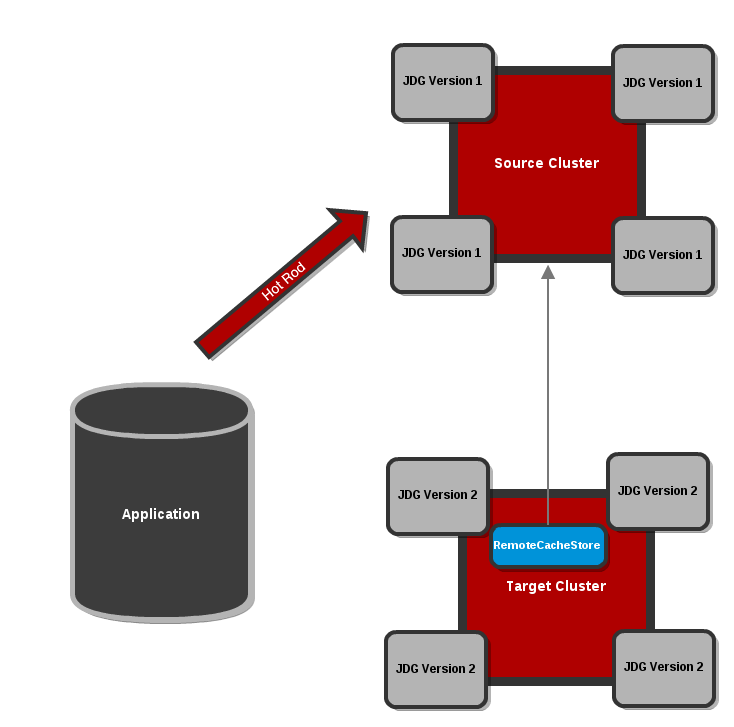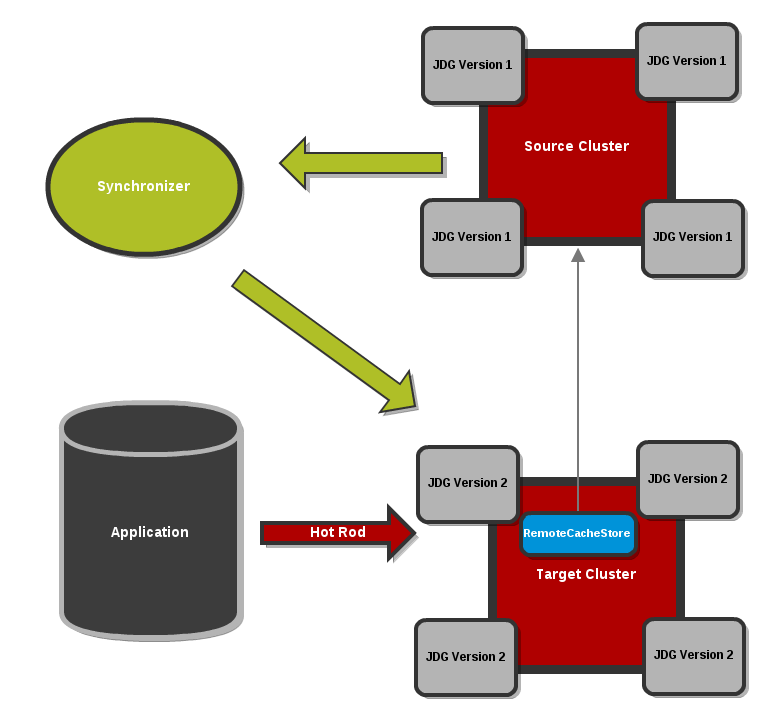Chapter 36. Rolling Upgrades
In Red Hat JBoss Data Grid, rolling upgrades permit a cluster to be upgraded from one version to a new version without experiencing any downtime. This allows nodes to be upgraded without the need to restart the application or risk losing data.
In JBoss Data Grid, rolling upgrades can only be performed in Remote Client-Server mode.
Important
When performing a rolling upgrade it is recommended to not update any cache entries in the source cluster, as this may lead to data inconsistency.
36.1. Rolling Upgrades Using Hot Rod
The following process is used to perform rolling upgrades on Red Hat JBoss Data Grid running in Remote Client-Server mode, using Hot Rod. This procedure is designed to upgrade the data grid itself, and does not upgrade the client application.
Important
Ensure that the correct version of the Hot Rod protocol is used with your JBoss Data Grid version. This version must be specified on the client programmatically, and instructions on defining this are found inside the JBoss Data Grid Developer Guide. A list of Hot Rod protocol versions from each release are found below:
- For JBoss Data Grid 7.0, use Hot Rod protocol version 2.5
- For JBoss Data Grid 6.6, use Hot Rod protocol version 2.3
- For JBoss Data Grid 6.5, use Hot Rod protocol version 2.0
- For JBoss Data Grid 6.4, use Hot Rod protocol version 2.0
- For JBoss Data Grid 6.3, use Hot Rod protocol version 2.0
- For JBoss Data Grid 6.2, use Hot Rod protocol version 1.3
- For JBoss Data Grid 6.1, use Hot Rod protocol version 1.2
Prerequisite
This procedure assumes that a cluster is already configured and running, and that it is using an older version of JBoss Data Grid. This cluster is referred to below as the Source Cluster and the Target Cluster refers to the new cluster to which data will be migrated.
Configure the Target Cluster
Use either different network settings or a different JGroups cluster name to set the Target Cluster (consisting of nodes with new JBoss Data Grid) apart from the Source Cluster. For each cache, configure aRemoteCacheStorewith the following settings:- Ensure that
remote-serverpoints to the Source Cluster. - Ensure that the cache name matches the name of the cache on the Source Cluster.
- Ensure that
hotrod-wrappingis enabled (set totrue). - Ensure that
purgeis disabled (set tofalse). - Ensure that
passivationis disabled (set tofalse).

Figure 36.1. Configure the Target Cluster with a RemoteCacheStore
Note
See the$JDG_HOME/docs/examples/configs/standalone-hotrod-rolling-upgrade.xmlfile for a full example of the Target Cluster configuration for performing Rolling Upgrades.Start the Target Cluster
Start the Target Cluster's nodes. Configure each client to point to the Target Cluster instead of the Source Cluster. Eventually, the Target Cluster handles all requests instead of the Source Cluster. The Target Cluster then lazily loads data from the Source Cluster on demand using theRemoteCacheStore.
Figure 36.2. Clients point to the Target Cluster with the Source Cluster as
RemoteCacheStorefor the Target Cluster.Dump the Source Cluster keyset
When all connections are using the Target Cluster, the keyset on the Source Cluster must be dumped. This can be done using either JMX or the CLI:JMX
Invoke therecordKnownGlobalKeysetoperation on theRollingUpgradeManagerMBean on the Source Cluster for every cache that must be migrated.CLI
Invoke theupgrade --dumpkeyscommand on the Source Cluster for every cache that must be migrated, or use the--allswitch to dump all caches in the cluster.
Fetch remaining data from the Source Cluster
The Target Cluster fetches all remaining data from the Source Cluster. Again, this can be done using either JMX or CLI:JMX
Invoke thesynchronizeDataoperation and specify thehotrodparameter on theRollingUpgradeManagerMBean on the Target Cluster for every cache that must be migrated.CLI
Invoke theupgrade --synchronize=hotrodcommand on the Target Cluster for every cache that must be migrated, or use the--allswitch to synchronize all caches in the cluster.
Disabling the
RemoteCacheStoreOnce the Target Cluster has obtained all data from the Source Cluster, theRemoteCacheStoreon the Target Cluster must be disabled. This can be done as follows:JMX
Invoke thedisconnectSourceoperation specifying thehotrodparameter on theRollingUpgradeManagerMBean on the Target Cluster.CLI
Invoke theupgrade --disconnectsource=hotrodcommand on the Target Cluster.
Decommission the Source Cluster
As a final step, decommission the Source Cluster.

